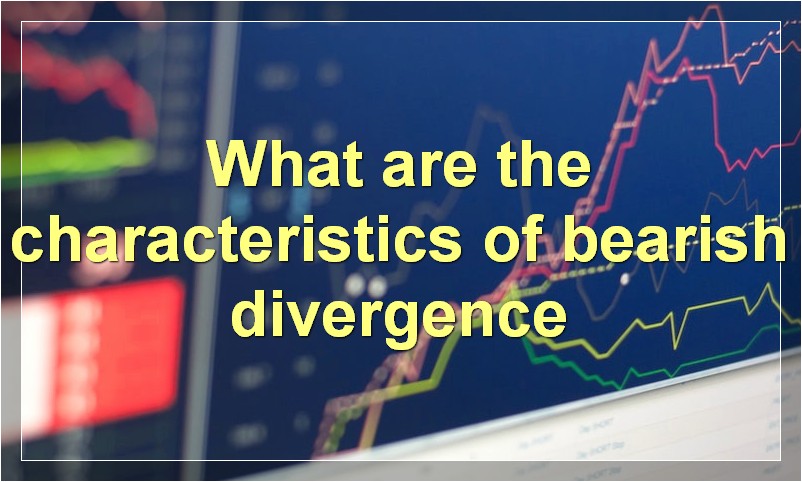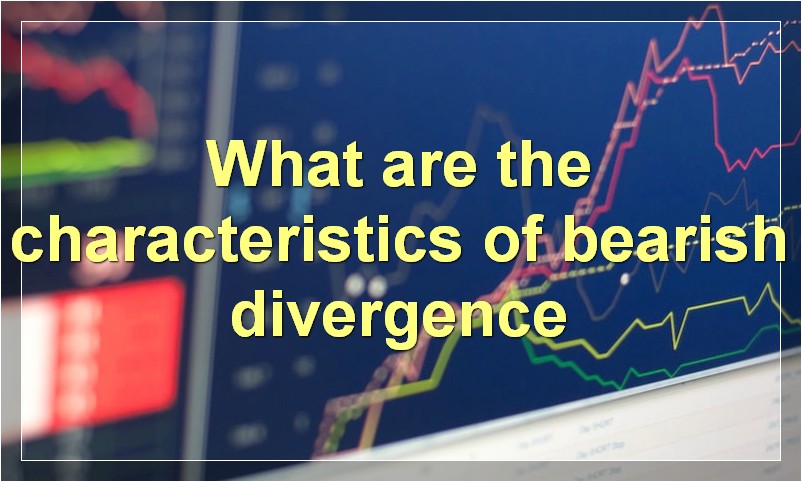Many investors believe that bearish divergence is a reliable predictor of stock market reversals, but there is significant evidence to the contrary.
What is bearish divergence
When it comes to trading, one of the most important things to look for is bearish divergence. This is a technical indicator that can be used to predict when a market is about to move lower.
There are two types of divergence: regular and hidden. Regular divergence occurs when the price action and the indicator move in opposite directions. Hidden divergence happens when the price action and indicator move in the same direction but at different rates.
Bearish divergence can be a sign that the current trend is about to reverse. It can also be an indication that a pullback is about to occur. Either way, it’s important to know how to spot this signal so you can make the best possible decisions when trading.
If you see bearish divergence on your charts, pay attention! It could be a sign that the market is about to move lower.
What are the characteristics of bearish divergence

There are several key characteristics of bearish divergence that investors should be aware of. First, bearish divergence typically occurs when the price of an asset is making new highs while the indicators are failing to confirm these highs. This can be a sign that the rally is losing momentum and that a reversal may be imminent. Second, bearish divergence is often accompanied by increased volume on the downside days, which can add to the signal’s strength. Finally, bearish divergence can sometimes be found in advance of major price reversals, making it a valuable tool for technical traders.
How do you identify bearish divergence
In order to identify bearish divergence, you will need to look at two different aspects of the market trend. The first is the price action, and the second is the volume.
When it comes to price action, you will want to look for a market that is making new highs, but the volume is decreasing. This is an indication that there are fewer buyers in the market, and that the uptrend may be coming to an end.
When it comes to volume, you will want to look for a market where the volume is increasing on days when the price is falling. This is an indication that there are more sellers in the market, and that the downtrend may be picking up steam.
Why is bearish divergence important
When it comes to technical analysis, bearish divergence is an important concept to understand. Simply put, bearish divergence occurs when the price of an asset is making new highs, but the underlying momentum indicators are failing to confirm these higher prices. This often happens before a sharp price decline and can be used as a warning sign by traders.
There are two main types of momentum indicators – leading and lagging. Leading indicators give signals before price changes occur, while lagging indicators provide confirmation after the fact. Some popular momentum indicators include the Relative Strength Index (RSI), Stochastic Oscillator, and MACD.
Bearish divergence can be a helpful tool for traders in identifying potential reversals in the market. However, it’s important to remember that divergences are not always accurate and should be used in conjunction with other technical indicators and analysis before making any trading decisions.
What can bearish divergence tell us about a market
Bearish divergence on a market chart occurs when the asset price reaches a new high, but the indicator (such as MACD, RSI, stochastics) fails to confirm the new high. This can be an early warning sign that the market is losing momentum and could be about to enter a downtrend.
What is the difference between bullish and bearish divergence

When it comes to technical analysis, there are a lot of terms that get thrown around. One of those terms is divergence. Divergence occurs when the price of an asset and a technical indicator move in opposite directions. There are two types of divergence- bullish and bearish.
So, what is the difference between bullish and bearish divergence?
Bullish divergence occurs when the price of an asset is making lower lows, but the technical indicator is making higher lows. This is seen as a sign that the current downtrend is losing momentum and that the asset could potentially reverse course and start trending upwards.
Bearish divergence occurs when the price of an asset is making higher highs, but the technical indicator is making lower highs. This is seen as a sign that the current uptrend is losing momentum and that the asset could potentially reverse course and start trending downwards.
Both bullish and bearish divergence can be used as a trade signal. However, it’s important to note that divergence alone isn’t enough to base a trade on- you should always look at the overall picture before making any decisions.
How does bearish divergence indicate a potential trend reversal
Bearish divergence is a technical analysis term that describes when the price of an asset and a technical indicator move in opposite directions. This can be an indication that the current trend is losing momentum and may be about to reverse.
Divergence is a powerful tool that can be used to identify potential trend reversals, so it’s important to know how to spot it. Here’s a brief guide on bearish divergence and how it can be used to signal a potential trend reversal.
What is Bearish Divergence?
Bearish divergence occurs when the price of an asset makes higher highs, but the technical indicator making lower lows. This shows that while the price is still moving up, the momentum is beginning to slow down. This can be an indication that the current uptrend is losing steam and may be about to reverse.
How to Spot Bearish Divergence
The easiest way to spot bearish divergence is by using a price chart and a technical indicator, such as the Relative Strength Index (RSI). Simply plot the RSI on your price chart and look for instances where the RSI makes lower lows while the price makes higher highs.
Here’s an example of bearish divergence on a 1-hour EUR/USD chart:
As you can see in the above chart, there were two clear instances of bearish divergence (marked with red arrows). In both cases, the price made a higher high but the RSI made a lower low, indicating that the uptrend was losing momentum. The first instance of bearish divergence led to a short-term pullback, while the second instance coincided with a more significant trend reversal.
How to Trade Bearish Divergence
There are several ways to trade bearish divergence, but the most common is to wait for confirmation before entering a short position. confirmation can come in the form of a candlestick pattern or a break of support. For example, in the EUR/USD chart above, you could have entered a short position after the second instance of bearish divergence was confirmed by a bearish engulfing candlestick pattern. Alternatively, you could have waited for price to break below support before entering your short trade.
Conclusion
Bearish divergence is a powerful technical analysis tool that can be used to identify potential trend reversals. While it’s not always 100% accurate, it’s still a valuable tool that should be part of any trader’s arsenal.
What are some common indicators of bearish divergence
There are a few common indicators of bearish divergence that investors and traders can look for to help confirm a potential trend reversal. Some of these include the MACD, RSI, and CCI indicators. Each of these measures momentum in some way, and when they start to diverge from price action, it can be a sign that the current trend is losing steam and may be ready to reverse.
Another potential indicator of bearish divergence is price action itself. If the stock is making new highs but the volume is declining, that could be a sign that buying pressure is waning and sellers are starting to take control. This is often seen as a leading indicator of a trend reversal.
Of course, no single indicator is infallible and divergence can occur without an immediate trend reversal. But if multiple indicators are showing signs of bearish divergence, it could be a warning sign that the current trend is losing momentum and may be ready to reverse course.
Can bearish divergence occur in any market
The answer to this question is a resounding yes! Bearish divergence can occur in any market, whether it be stocks, commodities, Forex, or even cryptocurrencies. The key thing to remember is that bearish divergence occurs when the price of an asset is making new highs, but the underlying momentum (as measured by a technical indicator) is failing to confirm these higher prices. This lack of confirmation by momentum can be a warning sign that the rally is losing steam and that a reversal may be imminent.
What role does divergences play in technical analysis
Divergence is a concept in technical analysis that suggests the potential for a future reversal in price. A bullish divergence occurs when the underlying security makes a new low, but the indicator does not. This is interpreted as a sign that prices will eventually move higher. A bearish divergence occurs when the security makes a new high, but the indicator does not. This is seen as a sign that prices may begin to fall soon.

